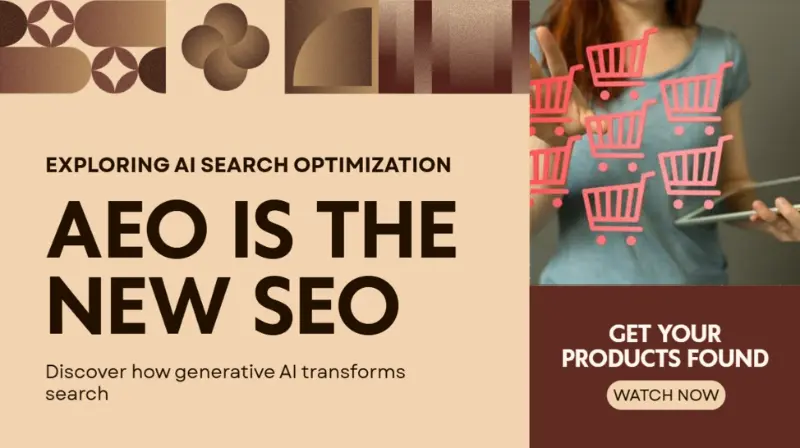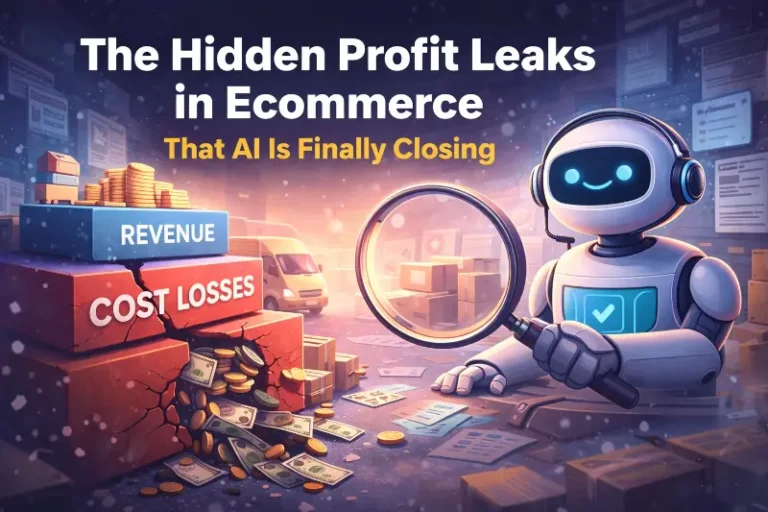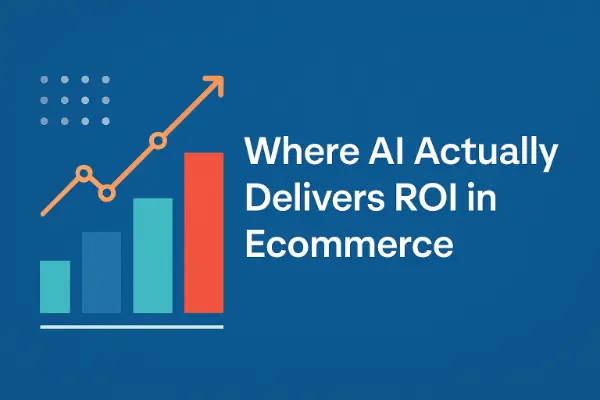AI Search Optimization: How AEO and GEO Are Reshaping Ecommerce SEO

Last updated on August 20, 2025

In this article
 6 minutes
6 minutes
- What Is AEO and GEO?
- Old SEO vs. New AI Search: What’s Actually Changing
- Why This Matters for Ecommerce Brands
- What We’ve Learned from Cahoot’s Own Content Shift
- The 4 Rules of AEO-Friendly Content
- AI Search Optimization for Shopify Brands
- Where to Focus First
- Let Me Be Blunt
- Final Thoughts: The Content You Publish Now Shapes How You Show Up Later
- Frequently Asked Questions
If your SEO strategy still revolves around exact-match keywords, you’re already behind.
AI search optimization is here, and it’s changing everything. From how your blog posts rank, to whether your product pages even get seen, to how Google and Perplexity summarize your content instead of linking to it. I’ve been neck-deep in ecommerce content for years, and I can tell you this shift is not incremental. It’s existential.
What Is AEO and GEO?
First, let’s unpack the acronyms everyone’s whispering about:
- AEO (Answer Engine Optimization): Optimizing for AI-generated answers, not blue links. Think Google’s AI Overview or Perplexity’s sidebar; these don’t link out unless they’re confident your content is the definitive source.
- GEO (Generative Engine Optimization): Tailoring your content to feed large language models the best possible structured, semantically rich information. GEO is about writing for the model, not just the human.
Together, these represent a massive evolution in how ecommerce content needs to be structured, written, and distributed.
Slash Your Fulfillment Costs by Up to 30%
Cut shipping expenses by 30% and boost profit with Cahoot's AI-optimized fulfillment services and modern tech —no overheads and no humans required!
I'm Interested in Saving Time and MoneyOld SEO vs. New AI Search: What’s Actually Changing
Let’s say you sell eco-friendly cookware. Under traditional SEO, you’d rank by optimizing for terms like “non-toxic frying pans” or “ceramic skillet USA made.” That still matters, but not in the same way.
In AI search:
- The model decides relevance, not just keywords.
- It often summarizes your content, not just links to it.
- If you’re not structured to answer the exact intent behind the query, you don’t show up, even if you rank.
So even if your article ranks #3 in Google, the AI Overview might feature a competitor who has better contextual clarity, semantic structure, or schema.
Why This Matters for Ecommerce Brands
Ecommerce brands often underestimate how many categories, products, and help articles become part of zero-click AI summaries. If a shopper asks:
“Are silicone baking mats safe?”
And your product page buries the answer in the 5th paragraph, or worse, doesn’t address it directly, you’re not getting surfaced. Another brand will.
Even worse? The AI might quote you but link to someone else, a review site, a Quora thread, even Reddit.
That’s what AEO punishes: weak content architecture and lack of clarity.
What We’ve Learned from Cahoot’s Own Content Shift
We started optimizing Cahoot’s ecommerce blog content for AEO/GEO in late 2024. It wasn’t about stuffing more keywords, it was about:
- Answering the core query in the first 100 words.
- Structuring posts semantically with proper H2, H3, and H4 usage and section labeling.
- Repeating intent-rich phrases like “shipment exception,” “multi-node fulfillment,” or “Walmart DSV shipping compliance” multiple times in natural ways.
- Embedding FAQs that mirror real-world queries (not just made-up ones).
The result? We’re seeing way more snippets, longer dwell times, and better AI Overview inclusion, without obsessing over backlinks.
Looking for a New 3PL? Start with this Free RFP Template
Cut weeks off your selection process. Avoid pitfalls. Get the only 3PL RFP checklist built for ecommerce brands, absolutely free.
Get My Free 3PL RFPThe 4 Rules of AEO-Friendly Content
If you’re creating blog posts, product pages, shipping policy FAQs, or comparison tables, here’s what you need to bake in:
- Write Like You’re Explaining to AI
Models need clarity, consistency, and repetition. Don’t be clever, be direct. Use terms like “Walmart Fulfillment Services fees” multiple times, and make every section serve a question. - FAQs Are Gold
These are your AEO frontline. Phrase each as a real query (think: “Is FedEx Ground faster than UPS?”) and answer them in tags, not in complicated tables or drop-downs. - Don’t Hide Your Answers
Don’t bury key product differentiators or return policy rules halfway down the page. AI isn’t scrolling, it’s scanning. - Schema Still Matters
Mark up reviews, pricing, FAQs, and organization details with structured data. You’re not doing it for Google’s web crawler, you’re doing it for ChatGPT, Perplexity, Claude, and whatever next model ingests your site.
AI Search Optimization for Shopify Brands
Shopify sellers are especially vulnerable here. Why?
Because most rely on thin content + generic templates. If your product page is just:
- Title
- Bullet list
- “Ships in 3–5 days”
Then AI search skips right over you.
Add in:
- Clear long-form descriptions
- Embedded questions + answers
- Shipping and return terms in plain language
- Customer reviews with quoted concerns and results
…and suddenly you’re more summarizable. More quotable. More linkable.
Scale Faster with the World’s First Peer-to-Peer Fulfillment Network
Tap into a nationwide network of high-performance partner warehouses — expand capacity, cut shipping costs, and reach customers 1–2 days faster.
Explore Fulfillment NetworkWhere to Focus First
If you don’t have time to redo everything, prioritize:
- Help Center articles (these get quoted often)
- Shipping & Return policies (Google surfaces these directly)
- Category-level content (for “best [category] for [need]” searches)
- Comparison pages (Perplexity loves these)
Then build forward-looking posts that clearly address queries like:
- “Is Shopify or Amazon better for small brands?”
- “What is Walmart DSV?”
- “How do I create a return policy for cosmetics?”
Because guess what? AI answers those, and who it quotes is not random.
Let Me Be Blunt
AI Search doesn’t reward clever. It rewards clear. It doesn’t care how beautifully your paragraph reads if it doesn’t match the user’s intent.
Most ecommerce brands are still optimizing for CTR in search when the real game is placement in the AI summary.
You want to be the quote, not the footnote.
Final Thoughts: The Content You Publish Now Shapes How You Show Up Later
Most LLMs ingest web content with a delay, so what you publish in August affects your visibility in October and beyond. If you’re planning for holiday, Prime Day, or peak, you need AEO-friendly content on the web today.
This is the new moat. Every article, every policy page, every FAQ that answers a real query in a structured, repetitive way, makes you more visible in the generative layer of search.
If you’re not writing for LLMs, you’re already losing traffic you never knew you were missing.
Frequently Asked Questions
What is the difference between AEO and traditional SEO?
AEO (Answer Engine Optimization) focuses on how content is summarized and surfaced in AI-generated answers, while traditional SEO focuses on ranking in search engine result pages. AEO prioritizes clarity, intent-matching, and semantic structure.
How does AI search impact ecommerce product pages?
AI search pulls from product pages that clearly answer user intent. Thin content or vague product descriptions are ignored. Pages with detailed explanations, structured data, and embedded FAQs are favored in AI Overview and zero-click answers.
Why are FAQ sections so important for AI Search Optimization?
FAQs mirror how people phrase questions in AI searches and voice assistants. Structuring your site with keyword-rich, clearly answered FAQs improves your chances of being featured or cited in AI-generated summaries.
Do I need to change my blog format for AI search optimization?
Yes. Blog articles should lead with clear answers, repeat target phrases naturally, use consistent subheadings, and avoid burying information. Writing for LLMs means making your content easily digestible and extractable.
Is structured data (schema) still relevant with AI search?
Absolutely. Structured data helps models understand your content’s context, pricing, reviews, organization, FAQs, and increases the chance of your content being quoted correctly or summarized accurately by AI tools.

Turn Returns Into New Revenue





